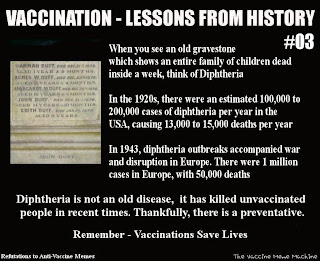Diphtheria. Today, we are no longer familiar with it - cases are extremely rare. Between 1936 and 1945, an average of 21,053 Americans got it, and an average of 1822 died http://jama.jamanetwork.com/article.aspx?articleid=209448. The numbers were fortunately low, because the diphtheria vaccine was one of the earliest developed - at the end of the 19th century a new treatment - an anti-toxin - was offered, and by the 1920s a new toxin-anti-toxin injection conferred immunity, with very limited side effects, as long as it was properly manufactured.
Without immunization, Diphtheria could and did wipe out whole families in a short period. Here are two graphic depictions, both courtesy of https://www.facebook.com/RtAVM?fref=ts. One, a meme that include a picture of a grave stone. The picture mentions little Dannah Duff, who died at 1 year and 9 months; little Agnes Duff, who died at the age of 6 years and 4 months; young John Duff, who died at the age of 11; and young Edith Duff, who died at the age of 8 - all within 11 days of each other:
The other, a letter, describing the death in less than a week of four young children, Lilly, 3, Agnes, 5, M.E., 7, and A.J., 11 (as best as I can tell from the letter), killed by the "fell destroyer". Not surprisingly, the parents are described as "disconsolate":
In a recent article cited on ScienceofMom, a doctor told the story told by a woman about her experience with diphtheria http://kckidsdoc.com/diphtheria-vaccine.html: "She was in the main room, propped up on pillows in an old brown chair. I remember watching her breathe, her chest sinking deep with every inhale. Sinking in. Bouncing out. Sinking in. Bouncing out."
The patient may recover at this point; or if enough toxin is absorbed, develop severe prostration, striking pallor, rapid pulse, stupor, and coma, and may even die within 6 to 10 days. Fever is usually not high, even though the patient may appear quite toxic. Patients with severe disease may develop marked edema of the submandibular areas and the anterior neck along with lymphadenopathy, giving a characteristic “bullneck” appearance."http://www.cdc.gov/vaccines/pubs/pinkbook/downloads/dip.pdf
Here is what that means:
Thanks to the vaccine, we are lucky enough not to see it very often. Since the vaccine, it is in the single digits. But it's still here - there are a handful of cases in the U.S. almost every year, and several thousand world wide (happily no more than that) http://www.who.int/immunization_monitoring/diseases/diphteria/en/ and it can come back, without the vaccine.




No comments:
Post a Comment